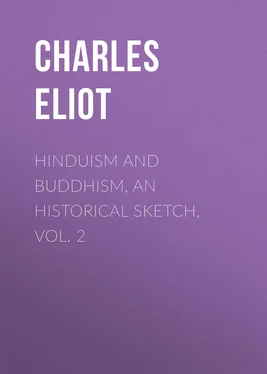Charles Eliot - Hinduism and Buddhism, An Historical Sketch, Vol. 2
Здесь есть возможность читать онлайн «Charles Eliot - Hinduism and Buddhism, An Historical Sketch, Vol. 2» — ознакомительный отрывок электронной книги совершенно бесплатно, а после прочтения отрывка купить полную версию. В некоторых случаях можно слушать аудио, скачать через торрент в формате fb2 и присутствует краткое содержание. Жанр: foreign_religion, Философия, Религиозная литература, foreign_psychology, foreign_antique, foreign_prose, на английском языке. Описание произведения, (предисловие) а так же отзывы посетителей доступны на портале библиотеки ЛибКат.
- Название:Hinduism and Buddhism, An Historical Sketch, Vol. 2
- Автор:
- Жанр:
- Год:неизвестен
- ISBN:нет данных
- Рейтинг книги:4 / 5. Голосов: 1
-
Избранное:Добавить в избранное
- Отзывы:
-
Ваша оценка:
- 80
- 1
- 2
- 3
- 4
- 5
Hinduism and Buddhism, An Historical Sketch, Vol. 2: краткое содержание, описание и аннотация
Предлагаем к чтению аннотацию, описание, краткое содержание или предисловие (зависит от того, что написал сам автор книги «Hinduism and Buddhism, An Historical Sketch, Vol. 2»). Если вы не нашли необходимую информацию о книге — напишите в комментариях, мы постараемся отыскать её.
Hinduism and Buddhism, An Historical Sketch, Vol. 2 — читать онлайн ознакомительный отрывок
Ниже представлен текст книги, разбитый по страницам. Система сохранения места последней прочитанной страницы, позволяет с удобством читать онлайн бесплатно книгу «Hinduism and Buddhism, An Historical Sketch, Vol. 2», без необходимости каждый раз заново искать на чём Вы остановились. Поставьте закладку, и сможете в любой момент перейти на страницу, на которой закончили чтение.
Интервал:
Закладка:
The other Bodhisattvas, though lauded in special treatises, have left little impression on Indian Buddhism and have obtained in the Far East most of whatever importance they possess. The makers of images and miniatures assign to each his proper shape and colour, but when we read about them we feel that we are dealing not with the objects of real worship or even the products of a lively imagination, but with names and figures which have a value for picturesque but conventional art.
Among the best known is Samantabhadra, the all gracious, 63 63 Chinese P'u-hsien. See Johnston, From Peking to Mandalay , for an interesting account of Mt. Omei.
who is still a popular deity in Tibet and the patron saint of the sacred mountain Omei in China, with which he is associated as Mañjuśrî with Wu-t́ai-shan. He is represented as green and riding on an elephant. In Indian Buddhism he has a moderately prominent position. He is mentioned in the Dharmasangraha and in one chapter of the Lotus he is charged with the special duty of protecting those who follow the law. But the Chinese pilgrims do not mention his worship.
Mahâsthâmaprâpta 64 64 Or Mahâsthâna. Chinese, Tai-shih-chih. He appears to be the Arhat Maudgalyâyana deified. In China and Japan there is a marked tendency to regard all Bodhisattvas as ancient worthies who by their vows and virtues have risen to their present high position. But these euhemeristic explanations are common in the Far East and the real origin of the Bodhisattvas may be quite different.
is a somewhat similar figure. A chapter of the Lotus (XIX) is dedicated to him without however giving any clear idea of his personality and he is extolled in several descriptions of Sukhâvatî or Paradise, especially in the Amitâyurdhyâna-sûtra. Together with Amitâbha and Avalokita he forms a triad who rule this Happy Land and are often represented by three images in Chinese temples.
Vajrapâṇi is mentioned in many lists of Bodhisattvas ( e.g. in the Dharmasangraha) but is of somewhat doubtful position as Hsüan Chuang calls him a deva. 65 65 E.g. Watters, I. p. 229, II. 215.
Historically his recognition as a Bodhisattva is interesting for he is merely Indra transformed into a Buddhist. The mysterious personages called Vajradhara and Vajrasattva, who in later times are even identified with the original Buddha spirit, are further developments of Vajrapâṇi. He owes his elevation to the fact that Vajra , originally meaning simply thunderbolt, came to be used as a mystical expression for the highest truth.
More important than these is Kshitigarbha, Ti-tsang or Jizō 66 66 Kshitigarbha is translated into Chinese as Ti-tsang and Jizō is the Japanese pronunciation of the same two characters.
who in China and Japan ranks second only to Kuan-yin. Visser has consecrated to him an interesting monograph 67 67 In Ostasiat. Ztsft. 1913-15. See too Johnston, Buddhist China , chap. VIII.
which shows what strange changes and chances may attend spirits and how ideal figures may alter as century after century they travel from land to land. We know little about the origin of Kshitigarbha. The name seems to mean Earth-womb and he has a shadowy counterpart in Akâśagarbha, a similar deity of the air, who it seems never had a hold on human hearts. The Earth is generally personified as a goddess 68 68 The Earth goddess is known to the earliest Buddhist legends. The Buddha called her to witness when sitting under the Bo tree.
and Kshitigarbha has some slight feminine traits, though on the whole decidedly masculine. The stories of his previous births relate how he was twice a woman: in Japan he was identified with the mountain goddess of Kamado, and he helps women in labour, a boon generally accorded by goddesses. In the pantheon of India he played an inconspicuous part, 69 69 Three Sûtras, analysed by Visser, treat of Kshitigarbha. They are Nanjio, Nos. 64, 65, 67.
though reckoned one of the eight great Bodhisattvas, but met with more general esteem in Turkestan, where he began to collect the attributes afterwards defined in the Far East. It is there that his history and transformations become clear.
He is primarily a deity of the nether world, but like Amitâbha and Avalokita he made a vow to help all living creatures and specially to deliver them from hell. The Taoists pictured hell as divided into ten departments ruled over by as many kings, and Chinese fancy made Ti-tsang the superintendent of these functionaries. He thus becomes not so much a Saviour as the kindly superintendent of a prison who preaches to the inmates and willingly procures their release. Then we hear of six Ti-tsangs, corresponding to the six worlds of sentient beings, the gracious spirit being supposed to multiply his personality in order to minister to the wants of all. He is often represented as a monk, staff in hand and with shaven head. The origin of this guise is not clear and it perhaps refers to his previous births. But in the eighth century a monk of Chiu Hua 70 70 A celebrated monastery in the portion of An-hui which lies to the south of the Yang-tse. See Johnston, Buddhist China , chaps, VIII, IX and X.
was regarded as an incarnation of Ti-tsang and after death his body was gilded and enshrined as an object of worship. In later times the Bodhisattva was confused with the incarnation, in the same way as the portly figure of Pu-tai, commonly known as the laughing Buddha, has been substituted for Maitreya in Chinese iconography.
In Japan the cult of the six Jizōs became very popular. They were regarded as the deities of roads 71 71 There is some reason to think that even in Turkestan Kshitigarbha was a god of roads.
and their effigies ultimately superseded the ancient phallic gods of the crossways. In this martial country the Bodhisattva assumed yet another character as Shōgun Jizō, a militant priest riding on horseback 72 72 In Annam too Jizō is represented on horseback.
and wearing a helmet who became the patron saint of warriors and was even identified with the Japanese war god, Hachiman. Until the seventeenth century Jizō was worshipped principally by soldiers and priests, but subsequently his cult spread among all classes and in all districts. His benevolent activities as a guide and saviour were more and more emphasized: he heals sickness, he leng thens life, he leads to heaven, he saves from hell: he even suffers as a substitute in hell and is the special protector of the souls of children amid the perils of the underworld. Though this modern figure of Jizō is wrought with ancient materials, it is in the main a work of Japanese sentiment.
CHAPTER XVIII
THE BUDDHAS OF MAHAYANISM
This mythology did not grow up around the Buddha without affecting the central figure. To understand the extraordinary changes of meaning both mythological and metaphysical which the word Buddha undergoes in Mahayanist theology we must keep in mind not the personality of Gotama but the idea that he is one of several successive Buddhas who for convenience may be counted as four, seven or twenty-four but who really form an infinite series extending without limit backwards into the past and forwards into the future. 73 73 In Mahâparinib. Sut. I. 16 the Buddha is made to speak of all the other Buddhas who have been in the long ages of the past and will be in the long ages of the future.
This belief in a series of Buddhas produced a plentiful crop of imaginary personalities and also of speculations as to their connection with one another, with the phenomena of the world and with the human soul.
In the Pali Canon the Buddhas antecedent to Gotama are introduced much like ancient kings as part of the legendary history of this world. But in the Lalita-vistara (Chap. XX) and the Lotus (Chap. VII) we hear of Buddhas, usually described as Tathâgatas, who apparently do not belong to this world at all, but rule various points of the compass, or regions described as Buddha-fields (Buddha-kshetra). Their names are not the same in the different accounts and we remain dazzled by an endless panorama of an infinity of universes with an infinity of shining Buddhas, illuminating infinite space.
Читать дальшеИнтервал:
Закладка:
Похожие книги на «Hinduism and Buddhism, An Historical Sketch, Vol. 2»
Представляем Вашему вниманию похожие книги на «Hinduism and Buddhism, An Historical Sketch, Vol. 2» списком для выбора. Мы отобрали схожую по названию и смыслу литературу в надежде предоставить читателям больше вариантов отыскать новые, интересные, ещё непрочитанные произведения.
Обсуждение, отзывы о книге «Hinduism and Buddhism, An Historical Sketch, Vol. 2» и просто собственные мнения читателей. Оставьте ваши комментарии, напишите, что Вы думаете о произведении, его смысле или главных героях. Укажите что конкретно понравилось, а что нет, и почему Вы так считаете.












